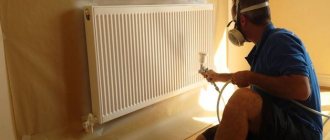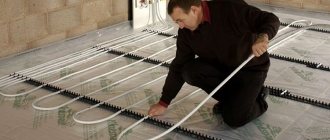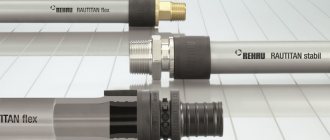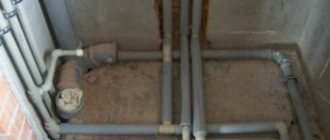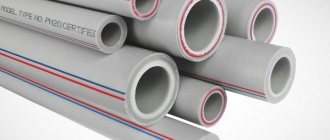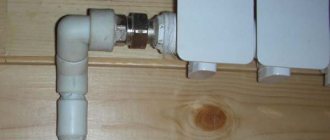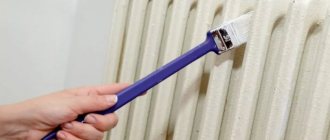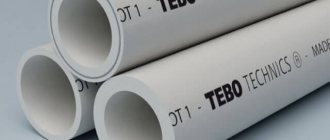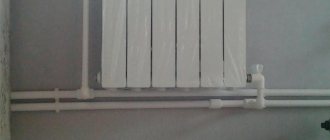How to paint polypropylene pipes - what paint?
To give plastic pipe products the desired color during their manufacture, various dyes are added to the source material.
There may be cases when the user, even before repairs, purchases blanks of the usual type, and he needs to paint them in a color suitable for the room. There is only one way to solve this issue - paint polypropylene pipes with a composition suitable for the design of the room.
Dye selection
Various types of coloring compounds can be used as a coating for polypropylene pipes, among which the following items stand out:
- standard paints used to protect metal surfaces;
- classic dyes intended for wall decoration;
- acrylic compositions, as well as mixtures designed specifically for plastic;
- polyurethane based dyes.
All of these types of coloring mixtures are commercially available and can be purchased at a hardware store.
Additional Information. When choosing a material suitable for painting polypropylene pipes, we advise you to contact the manager of a trade organization who will advise you on this issue.
When determining the coating application method for polypropylene, we proceed from the characteristics of the selected composition. Let's consider each of the options proposed above in more detail.
We recommend that you read: Is metal-plastic or polypropylene better for plumbing?
Preparatory work
Experts know very well how to properly paint plastic pipes. One of the main points of the process is the choice of dye. And strict adherence to the rules for applying the composition.

Paint in cans
This is the only way to achieve good and durable painting of the entire or just a separate part of the utility line.
When the decision is made to coat the pipes with paint, you need to choose a material. For a hot water system, you will need a special composition that is heat resistant. In addition, it is necessary to protect the floor and walls from paint drops.
Is it possible to paint polypropylene pipes?
Many owners have a question about whether it is permissible to paint plastic pipes.
Experts say that they can be painted. The main thing is to choose a good suitable paint and follow the correct painting technology. In this case, it will be painted with high quality and for a long period.
The only problem with painting plastic pipes is how to do it correctly, so that the painted materials remain beautiful for many years, and do not peel off and crack every month.
So, having decided to paint the pipes in your home, you should adhere to the following stages of work:
- If they are already installed, then you need to come up with a design for the room in which they are located. If this is a bedroom, then it is best to paint the pipes to match the color of the wallpaper or curtains - this way it will be less noticeable. And if it’s a children’s room, then you can add originality and paint it in a bright color. For example, with pink wallpaper, you can make an element of raspberry color or, conversely, a more pastel shade. You can also come up with an ornament. For example, make it with polka dots or stripes. You should not proceed to the next stage without resolving the issue with the interior of the room. Nobody wants to paint an element a hundred times: there is no need for unnecessary hassle and waste of money. Therefore, it is better to think through everything down to the details from the very beginning. You can use the Internet and look at alternative options, and then add something of your own.
- Having decided on what you want, you can go to the store. Here you have to choose the paint that will stick well to the pipes without losing its appearance. Painting pipes with regular paint is just a waste of money. This type of paint will not last long and will begin to peel off even before the heating season. Therefore, you need to familiarize yourself with the range of paints specifically for plastic. It is worth considering that not only cold but also hot water is supplied through the pipes in the house. That is, the paint must be designed to withstand heat.
Polypropylene pipes, threaded transitions and fittings for connections.
When choosing paint, it is better to contact a specialist in the appropriate store. He is more aware of their characteristics and features. You need to explain to him what exactly needs to be painted, how and where. But since there are different consultants, it’s still worth having at least some idea about paints. So, for polypropylene pipes it is suitable:
- ordinary paint for metal;
- Wall paint;
- acrylic paint;
- special paint for plastic.
The choice of paint should be influenced by the type of polypropylene pipes.
- You can paint a pipe using different methods.
How to choose paint?
The final result of your work depends not only on how the paint is applied to the metal, but also on how high quality it is and how suitable it is for such work. Paint for heating pipes must meet the following requirements:
- heat resistance from 100°C;
- resistance to abrasion and aggressive cleaning agents: pipes and radiators have to be washed quite often;
- non-toxic: during the heating process, the paint coating should not release odors or harmful substances into the air.
Types of paints
Today on the market you can find paints with different component compositions.
Acrylic enamels are produced on the basis of organic solvents, so painting pipes is inevitably associated with an unpleasant, pungent odor. However, the result will be a durable glossy finish that will retain its integrity and attractive appearance for a long time.
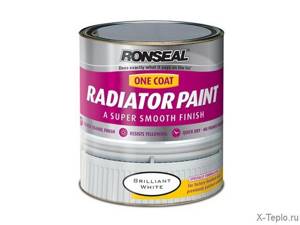
Alkyd paints are also in great demand for transforming pipes and radiators. Their downside is the pungent odor not only during the painting process, but also during operation. But the layer turns out to be really durable. Alkyd paints are distinguished by a richness of shades.
Water-dispersed enamels are attractive because they do not require much time to dry pipes and radiators, and the painting itself takes place without emitting a pungent odor, because these enamels do not contain caustic solvents.
What plastic pipes can be painted?
There are different types of plastic, and each material has its own properties. There is a material that cannot be painted at all. If plastic pipes are made of polypropylene or polyethylene (PE), then it is almost impossible to paint them well and no matter what you paint them with, any paint will begin to peel off them.
Plastic based on PVC or ABS can be painted, but its surface must first be coated with a special primer.
When choosing a paint, you need to look at the following characteristics:
— the presence of organic compounds in its composition;
- drying time: it should not be more than twelve hours;
— degree of repulsion from the surface and hardness.
Heat-resistant acrylic enamel
Odorless pipe paint is acrylic enamel. Due to the fact that it does not have a pungent odor, this enamel is an ideal paint and varnish material for work carried out inside residential premises. The painted surface becomes absolutely smooth and tactilely resembles plastic.
Since not all acrylic enamels are heat-resistant, when purchasing, you must carefully read the information regarding the temperature range of its use. The minimum value for using these enamels is 80 ºС.
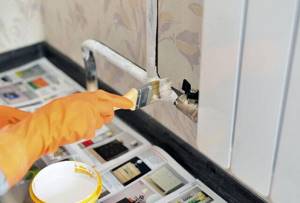
A significant advantage of these paints is their drying time - for the first layer the value ranges from ten minutes to one hour, and from one to two hours for the second. To achieve a high-quality result, it is necessary to prime the surface to be painted. When carrying out work, it is necessary to avoid contact with moisture on the surface to be painted.
The consistency of acrylic resembles medium-thick sour cream; it does not spread, which eliminates the possibility of smudges. As stated above, this enamel should be applied to a previously primed surface in two layers. Violation of painting technology entails a significant deterioration in its quality.
The only drawback of using this material is its low resistance to mechanical loads.
Instructions for painting pipes
In order for the result to be pleasing and the painting work not to have to be redone, spending extra money and time, it is necessary to adhere to the technology and follow the recommendations of specialists. The quality of preliminary surface preparation often has a greater impact on the durability and aesthetics of the coating than the choice of paint.
Preparatory work
First of all, you need to take care of protecting the floor, walls and surrounding objects. Old newspapers, magazines, oilcloth or construction film are suitable for this. No matter how hard you try to do everything carefully, paint can still drip or splash in the most inappropriate place. Therefore, it is better to play it safe so as not to think later than to remove paint stains.
On a note! Personal protective equipment will be useful for work: gloves, a hat, work clothes that you don’t mind getting dirty. If you use paint with a smell, you will also need a respirator.
Before painting, the surface of the pipes must be cleaned of dust, dirt and old paint. If the previously applied layers of paint are thin enough, adhere well and do not crack, then you can leave them and just get by with sanding them with sandpaper. Areas with rust need to be treated especially carefully. White spirit or any slightly alkaline solution works well for degreasing the surface.

You can get rid of old paint in the following ways:
A gel-like liquid is applied to the surface and covered with film. After a short period of time, the old coating softens and is easily removed with a spatula, scraper or wire brush. Paint remover has a strong odor and contains aggressive toxic substances, so you must work with extreme caution.
- Using a blowtorch.
The paint heats up and comes off easily under the pressure of a spatula or similar tool. Can only be used when working outdoors.
- Using a hair dryer.
Due to heating, the old coating easily comes off and can be cleaned off with any sharp object. This method is similar to the previous one, only simpler and safer, and can be used in any room. Due to the ability of metal to quickly give off heat, it is not always possible to warm it up well, so in some cases using a hair dryer will be ineffective.
- Using a drill or grinder with a wire brush attachment.
Old paint can be cleaned off quite quickly, but in hard-to-reach places the brush is powerless; you need to use a narrow spatula, knife or chisel.

The best way to remove paint from pipes and radiators depends on the availability of suitable tools and subjective individual preferences. But in any case, the old cracked coating must be removed so that the new one fits well and lasts a long time. Then the surface is degreased, wiped with a damp cloth and dried.
After complete cleaning of all accumulated layers or when dealing with a new uncoated metal surface, an anti-corrosion primer should be applied if the paint does not contain special protective components. In some cases, the ability of the primer to improve adhesion to the substrate is important. If you use 3-in-1 paint containing a rust converter, primer and color pigments, you can immediately begin applying it without prior preparation.
Important! Regardless of the type of paint and varnish material, work should be carried out in a well-ventilated area. Any paint fumes contain substances that should not be inhaled unnecessarily. Therefore, it is recommended to ensure that pets, children and other family members are away from you during painting.
Applying paint
There are several methods to paint pipes:
- With a brush;
- Roller;
- Spray can;
- Spray gun or spray gun.
Applying paint with a brush is the most common and affordable option. No special skills are required. It’s enough just to take a good brush and, picking up a small amount of paint on the tip, spread it evenly, slowly, over the surface. You must strive to make the layer as thin as possible. This will ensure uniform coverage and no smudges. If the paint shows through, it is better to paint it again later than to apply one thick layer.
Advice! Cheap brushes often have bristles that fall out. Therefore, it is not worth saving on their cost. However, even high-quality specimens sometimes leave hairs. If necessary, lint can be removed with a needle.
It is very convenient to paint pipes and batteries using a special radiator brush. It has a long handle and a curved shape that makes it easy to cover all those hard-to-reach areas.
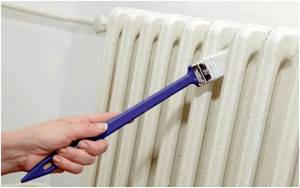
Using small-diameter foam rollers, it is convenient to paint an openly located pipeline if there is free space around. They are also suitable for the front surface of heating devices. Craftsmen even make special devices from two rollers, allowing not only to ensure an even application, but also to complete the job very quickly.
Sometimes simple scouring pads are used for smooth pipes, allowing you to apply a neat thin layer on all sides. The gloves will, of course, be dirty, but the painting will be completed in no time.
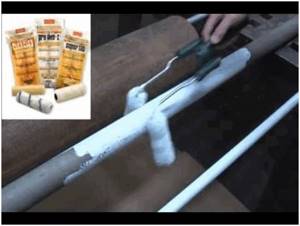
Working with a spray can is the most convenient and fastest. It must be shaken for a minute and can be sprayed onto the prepared surface. Performing smooth zigzag movements, gradually cover the required area. It is important to maintain the distance recommended by the manufacturer and not stay in one place for too long.
Aerosol cans provide a beautiful decorative finish, but are expensive and do not cover hard-to-reach areas well. In this regard, they are usually applied to a well-primed base or after a preparatory background coat of paint.
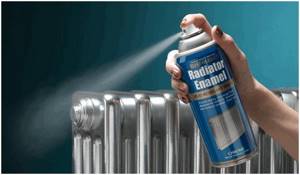
A professional spray gun is used quite rarely in everyday life, but if there is a lot of painting work to be done, then it is worth acquiring this device. The sprayer allows you to quickly apply even layers with minimal paint consumption and has special nozzles for ease of working with surfaces of the most intricate shape.

Useful tips
Expert advice on how best to paint heating pipes will help you do the work yourself with the best results:
- When removing the old layer of paint, it is important not to overdo it, applying force so as not to damage the pipe connections.
- It is necessary to open the container with paint remover very carefully, holding the bottle with the neck away from you, so as not to inhale toxic fumes. Work with this caustic substance can only be carried out if the room is well ventilated.
- If it is possible to dismantle the heating devices, this will significantly facilitate the painting process. Radiators can be taken outside and painted in the fresh air, turning them on the convenient side.
- It is best to paint pipes and radiators with the heating system turned off. Otherwise, the paint will lie unevenly on hot surfaces, and there may be streaks, blisters, spots and streaks.
- If it is necessary to carry out work during the heating season, you can get out of the situation by closing the valves on the batteries and waiting for them to cool completely. At the same time, the room will become noticeably colder, and only the radiators will be well painted, since the pipes will still remain hot.
- You need to paint from top to bottom with gentle movements, slowly.
- You should strive to paint the surface on all sides, and not just the front. Otherwise, the remaining parts will rust, and unpainted areas are always noticeable, although not at first glance.

Technology for painting polymer pipes
You can paint hot pipes made of polymer materials only after preliminary preparation. This is due to the fact that the glossy surface of the pipe prevents high-quality adhesion of the paint, and the coating will leave much to be desired, which will entail the need to apply several layers of paint. To prevent this, the surface of the pipe is cleaned with sandpaper.
Note! To process pipes, fine-grained sandpaper is used and the work is carried out without the use of power tools, since it is necessary to create only a slight roughness. Using a power tool can scrub the pipe too deep. During the heating season, polymer pipes can be painted only after sandpapering.
At the next stage, the pipes are wiped with a damp cloth after sanding to remove dust. Make sure the pipes are dry and clean before painting. After this, it is necessary to cover the floor and walls with protective material (film) to prevent paint from entering.
Preparing to paint iron pipes
Before you begin painting your water pipes, you need to determine what they are made of. Temperature also matters when choosing paints. In addition to paint and a brush, it will be impossible to do without sandpaper, gloves, a rag, a cuvette and primer. If the pipes are covered with old paint, it must be removed. After their surface is cleared of it, it will need to be sanded. This removes rust. After this, the surface of the pipes is degreased. Then all the garbage is removed, and fresh air is allowed into the room. Only after all this do the coloring begin. To prevent paint from dripping onto the floor, the brush must be held over some kind of vessel.
READ ALSO: Soldering iron for polypropylene pipes - tool characteristics, selection parameters - Article - Magazine
Paint selection
Now let's find out how to paint heating pipes. The final result will directly depend on choosing the right paint. When choosing paint, you must proceed from the requirements that apply to them. So, paint for heating pipes and radiators should have:
- high heat resistance (not lower than 100 degrees);
- abrasion resistance;
- not be toxic;
- resistance to aggressive environments.
Types of paints for heating pipes
There are paints on sale that are specifically designed for painting heating pipes:
- Acrylic enamels. They are produced on the basis of organic solvents, so painting heating pipes with their help and the drying process will be accompanied by a characteristic smell of the solvent. However, this justifies the end result - glossy shine and long service life.
- Alkyd enamels. When used, they also emit an unpleasant odor, which can later be felt when the heating system is operating. But the surface painted with such paint will be resistant to abrasion and high temperatures. It should be noted that manufacturers produce a fairly wide range of colors of this paint, which can satisfy any demand. Due to this, it is quite popular among consumers.
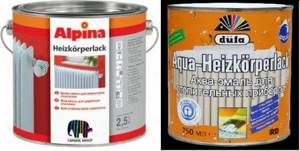
Heizkorperlack water-dispersion paint from the Dufa and Alpina brands is perfect for the restoration of radiators and heating pipes
- Water-dispersion paints. Painting heating pipes with water-dispersion paints that are specifically designed for this purpose is the most common choice. There is no specific smell when working with them, and they dry very quickly.
There is also oil paint, but now it is rarely used for such purposes.
What paint should I use? The final choice always remains with the consumer.
The best manufacturers of paints for painting heating pipes
Manufacturers, both domestic and foreign, produce a wide variety of paints that differ in color and quality. The price most often depends on the brand of paint and manufacturer. Among the countries producing paints that can satisfy virtually any taste, we should note Holland, Germany, Sweden, etc.
Thus, Radiator Paint enamel produced in Holland is white in color and after painting allows you to obtain a flawless glossy surface.
Heizkorperlack enamel and Mipatherm 600 paint produced in Germany are famous for their quality and do not require preliminary surface preparation. Within 3-4 hours after applying such paints, you can turn on the heating system, which is an advantage if repairs are carried out in winter.
Alkyd paint Elementfarg Alkyd produced in Sweden is used both as a primer and as a paint, which is very important, because There is no need for a separate primer. It is enough to just paint the surface in 2 layers.
Paint for plastic pipes
The choice of paint must be approached no less responsibly. Only by taking into account all the subtleties and choosing the right composition with which to paint a PVC pipe can you achieve a lasting color for many years. What ingredients to pay attention to:
- Finishing paints for walls and ceilings;
- Polyurethane dyes;
- Paints for metal surfaces;
- Acrylic.
Please note: Sole painting: surface cleaning and black or white coloring technology
Any of the options is suitable for PVC or ABS pipes with cold water or sewerage. When painting coolants, you need to choose a heat-resistant coating. Let's take a closer look at each type and decide what paint to paint the pipes with.
- Composition for walls and ceilings Among the advantages of use, it is worth noting the economy and the perfect match of colors in the interior. You don’t have to incur additional costs and use leftover paint after the renovation. But you cannot paint heat conductors with wall dye; it will soon peel off, since it is not intended for heating. You should also not use water-based paint, as its composition will destroy the plastic and will cause damaged pipes to be replaced over time. If you still decide to use an unsafe coating, you need to protect the surface with alkyd enamel. It will cover the plastic and prevent it from breaking.
- Paints with polyurethane Widely used for painting PVC and ABS pipes. The paint applies evenly, does not require more than one application and can withstand heat. Manufacturers offer a huge palette of colors, so it’s easy to choose the right one for your interior.
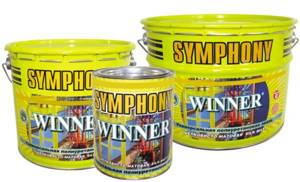
- Metal compositions Available and often used. The range of shades is amazingly diverse, the paint is easy to apply, does not require a second coat and can withstand heat. There is no need to prepare the surface in advance, apply a degreaser or primer. This saves time and money. But there are also disadvantages. Firstly, the consistency is thick. The mixture must be applied either very quickly and professionally, or in combination with a solvent. Secondly, there is a strong unpleasant odor that remains in the room for several days. For safety reasons, it is better to work with metallic paint in a respirator or at least with an open window. Otherwise, you can get nausea, dizziness, headaches and other delights of intoxication.
- Acrylic and special mixtures Intended by the manufacturer for painting plastic pipes. The paint composition does not damage the plastic, lays down in an even layer and lasts a long time. Of the minuses note:
- high cost of paint;
- service life comparable to previous materials.
Pay attention to: How to paint a wooden table: ways to decorate vintage furniture
Before painting with acrylic, you must apply a layer of primer, then the result will exceed expectations.
- Pre-priming A method that allows the use of paint of any composition and manufacturer. The trick is to first apply an aerosol primer to the pipe, which is used when painting cars. You can buy it in auto stores, service stations or tire shops. The primer mixture in an aerosol is ready for use after shaking, does not require mixing or dissolving, is easy to apply and dries quickly. This method is also widely used by craftsmen.
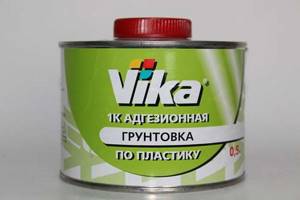
Types of compositions
As mentioned earlier, each type of pipeline must have its own paint:
- The most capricious in this regard are heating wiring and radiators;
- External pipelines can be placed behind them;
- The least capricious, but also requiring attention, is the plastic wiring.
Painting heating wiring
- Currently, alkyd compounds are rightfully considered the first in popularity here . They form a strong, stable covering film, which has fairly good elasticity indicators, which is very important for surfaces subject to thermal expansion. Alkyd enamels have an enviable glossy sheen, but since they are based on an organic solvent, they smell strongly during application and require good ventilation.
- Water-emulsion or water-dispersed mixtures can theoretically be used . These paints apply well, have no odor, but they are not durable, plus they cannot be used everywhere for heating systems due to the fact that they have a heat-insulating effect.
- Acrylic and acrylate enamels are a relatively new product on the market and during this time they have gained a lot of fans . They can be either matte or glossy. They have high abrasion rates and good heat capacity. The coating itself is a thin, elastic layer of plastic polymer. The only serious drawback of these enamels can be considered the high price.
Types of products used
There are various product options that have the required characteristics.
Recently, oil paint for heating pipes is almost not used due to its disadvantages: pungent odor, long drying time, color changes under the influence of high temperatures.
The most common types of paints used for heating pipes and radiators are the following:
- acrylic enamels are strong, durable, giving the surface a glossy shine. However, their disadvantage is the unpleasant odor during the painting process, which, however, quickly disappears;
- alkyd enamels are resistant to high temperatures and abrasion, the coating is very durable and uniform. They are distinguished by a rich variety of shades. But their significant disadvantage is a pungent odor that can last up to three days and can be felt when the heating is on;
- water-dispersion emulsions should be chosen when odorless paint for heating pipes is needed. They are easy to apply, creating an even coating, dry quickly, and do not have an unpleasant odor. You should definitely check that the labeling indicates that it is intended for painting radiators.
Experts recommend
Any work requires a rational approach, including painting the heating system.
In order to do this professionally, with the least expenditure of effort, energy and money, you should take into account the advice of those who understand this:
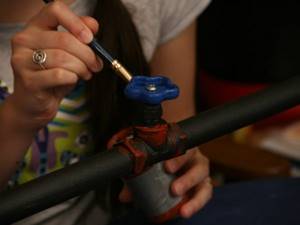
- Before painting, you need to evaluate the heating system in order to choose the right coating that meets all the requirements of the latter.
- The next stage is preparation for painting: remove rust and old paint, clean it down to the metal base, and degrease the surface as much as possible. Apply the coating only at least six hours after stripping the metal, after using a primer. It can be called a base for paint, which ensures even application and better fixation of the coating. Otherwise, the heating system elements will quickly rust.
- The primer must match the structure of the future coating. Sometimes you can immediately choose it and paint for pipes from the same manufacturer. However, in the case of coating with anti-corrosion paints, which, by the way, can withstand heating up to six hundred degrees, a primer is not required.
Attention: Plastic pipes should only be cleaned using chemical methods. Mechanical processing will definitely ruin the material. But for pipes made of non-ferrous metal, on the contrary, mechanical cleaning methods are recommended.
- Still, despite the unique properties of alkyd enamels, it is better to paint radiators and pipes when they have completely cooled, so as not to repaint streaks and stains later. In this case, it is advisable to remove the battery, and if it doesn’t work, use a spray bottle or spray can for especially hard-to-reach places. This will save time and the work will be neat.
- If you paint the radiator, do it from top to bottom to prevent accidental drips on already finished surfaces.
- It is necessary to apply a protective coating on all sides, since over time, unpainted elements will begin to rust, which can lead to additional costs for protective enamels or a new battery altogether. And you need to apply the paint in several layers (about 2-3) with intermediate drying.
- When painting a cast iron battery, it is important to first remove traces of the old coating, otherwise the new one will quickly crack and peel off. Do not bypass the stage of priming the surface before coating. For cast iron systems, smooth foam rollers of small diameter are used for a more even application of enamel. A glossy coating will reveal all the unevenness of the radiator, but will quickly turn gray on cast iron. Here it is better not to choose white or light colors.
- If you like hammer enamel, prepare a radiator. The surface should be rough (skin can be used).
- Cheaper acrylic paint options turn yellow quickly. They should not contain chalk.
- To dilute acrylic paint, you need to have water, alcohol or vodka. You should not pour the solvent directly into a can of paint; it is better to do this in a separate container.
- Close the can of leftover paint tightly, otherwise it will dry out and become useless.
You already know how to paint copper heating pipes and others. Select the dye and apply it correctly, then the issue of painting will not bother you for a long time. The instructions will help you do everything correctly and avoid mistakes.
Features of application
Dyes for metal
Advantages of using regular metal paint:
- the availability of this dye, widely used in everyday life;
- reasonable cost;
- ease of preparation for application, which does not require pre-treatment of the surface of polypropylene pipes with special protective agents.
When working with this product, no material preparation is required; You just need to apply paint on it and wait for it to dry.
Note! For this purpose, a spraying method is used, implemented using a special spray gun.
But this method also has disadvantages, which are manifested in the sharp and unpleasant smell of the dyes, as well as the fact that they have a very thick consistency. Therefore, you should work with them as quickly as possible or use a solvent specially designed for diluting these paints.
Regular dyes to match the color of the walls
This approach has even more disadvantages and they are expressed in the instability of the coloring compositions used in heating systems. Wall paint is not designed to withstand high heat, so the coating will lose its original appearance over time.
Its deterioration usually manifests itself in peeling of the top layer of dye and its gradual falling off in the form of characteristic scales.
But this option also has its advantages, expressed in the invisibility of pipelines against the background of walls, the versatility of the compositions used, as well as an expanded range of colors.
Painting with compositions based on acrylic and polyurethane
Dyes of this class are among the “softest” of all household mixtures used for painting pipes. The solvent they contain does not pose a danger to plastic, which has a wide range of colors. In addition, such compositions are easily applied to pipe surfaces and do not have a pungent odor.
The disadvantage of such materials is the threat of cracking under strong heating, which is possible when they are used for painting workpieces of limited thickness used in heating systems.
Let's add to this that before applying acrylic to the surface, the latter must first be thoroughly primed.
Polyurethane paints are used extremely rarely for these purposes, which is explained by the need for preliminary priming, as well as the limited temperature range.
Use of special dyes
The only drawback of special compositions for painting polypropylene is their high cost. Despite this, many users note that they do not last any longer than the materials already discussed.
In this case, you don’t have to worry about the safety of polypropylene.
The solvent contained in these dyes is completely safe for pipe products, and their resistance to high temperatures allows them to be used in heating lines.
After painting with these mixtures, the pipes must be left to dry for some time. The drying speed of paint depends on the current time of year and increases significantly on hot and dry summer days.
Painting pipes with priming
This option for painting polypropylene is fundamentally different in its approach to surface preparation. It involves the use of a special primer, which is available in the form of an aerosol.
The primer composition reliably protects the surfaces being treated and ensures good adhesion to the paint used.
Additional Information. This protective agent is used when painting car bodies, so you can find it in car repair shops.
In conclusion, we note that in order to give the elements of water supply and heating systems the desired color shade, it is necessary to be able to choose the right type of dye and method of its application. This can be achieved after studying the recommendations discussed in our review.
infotruby.ru
